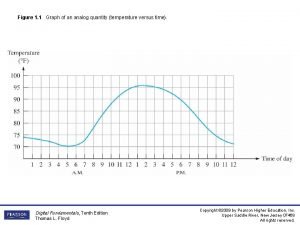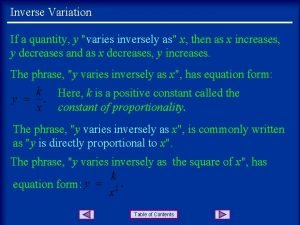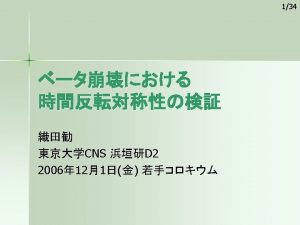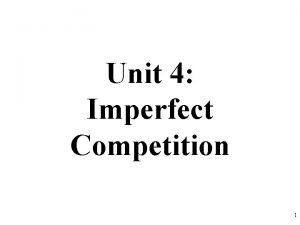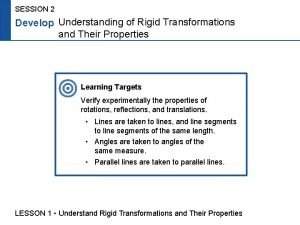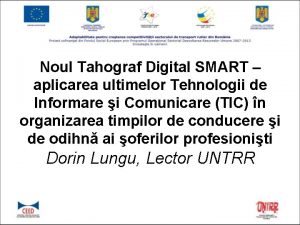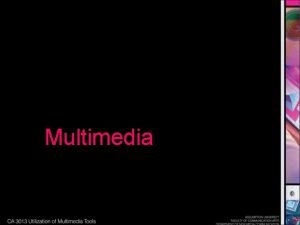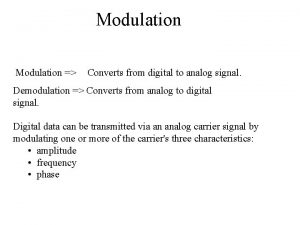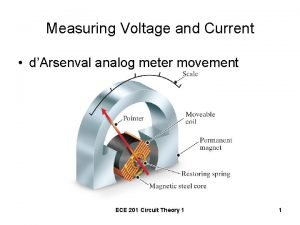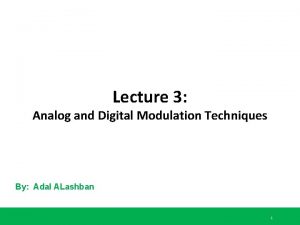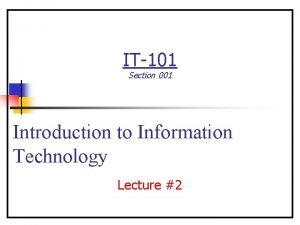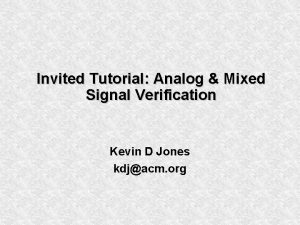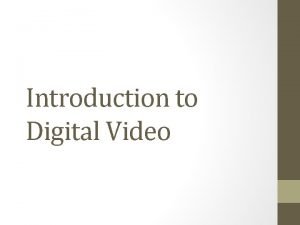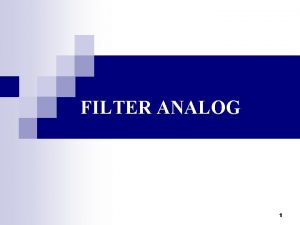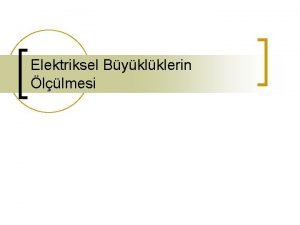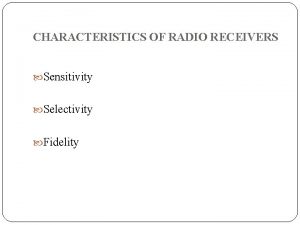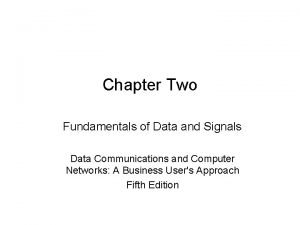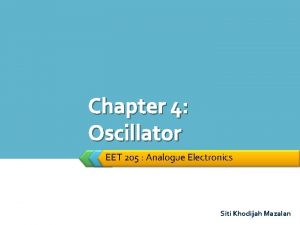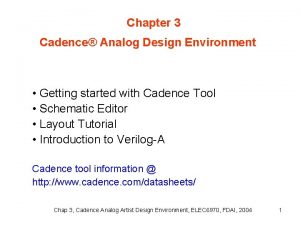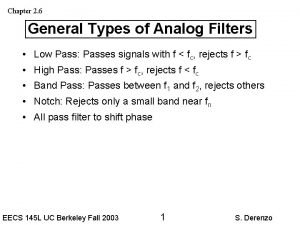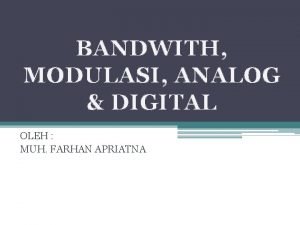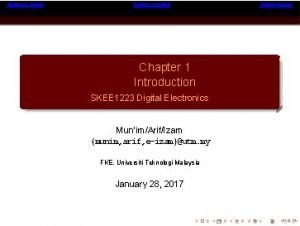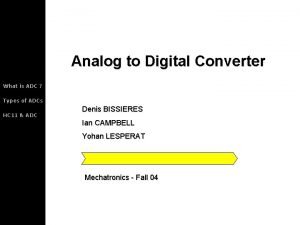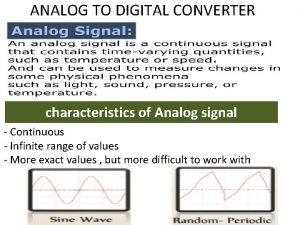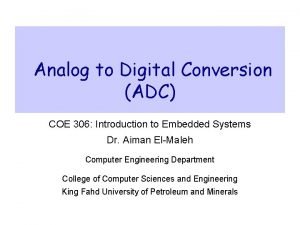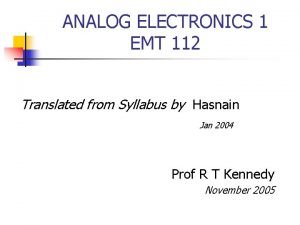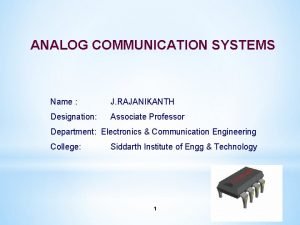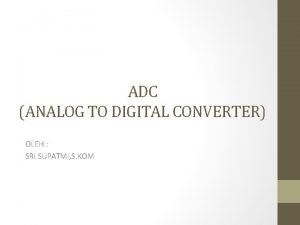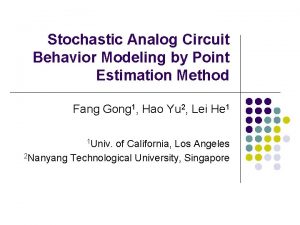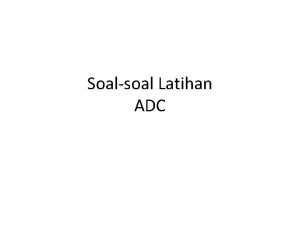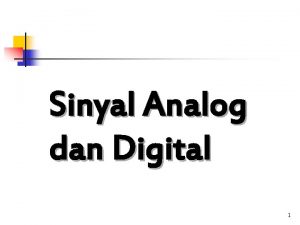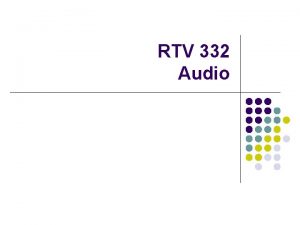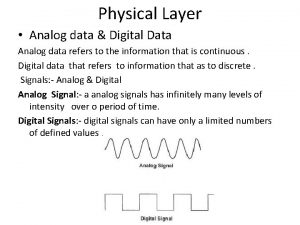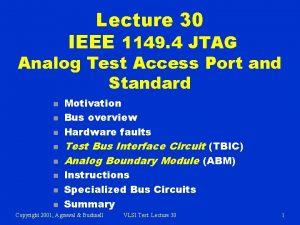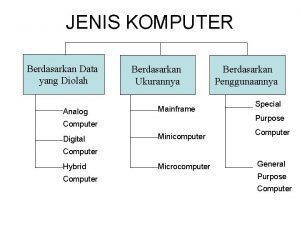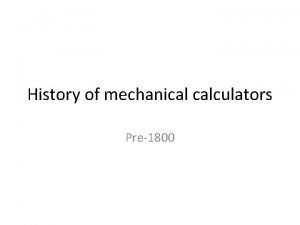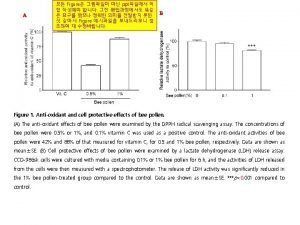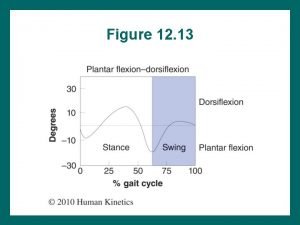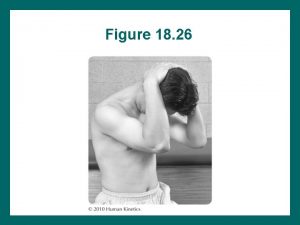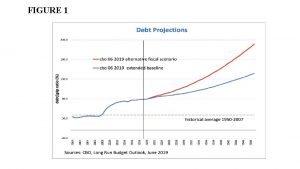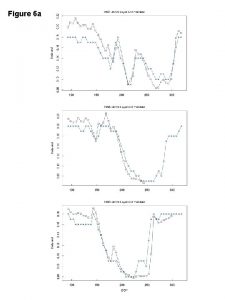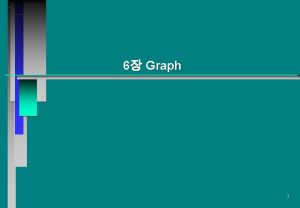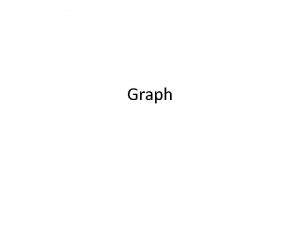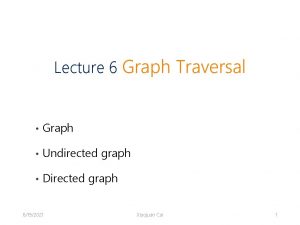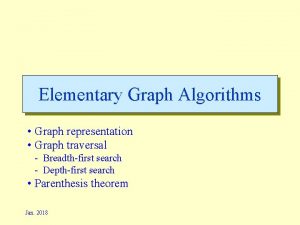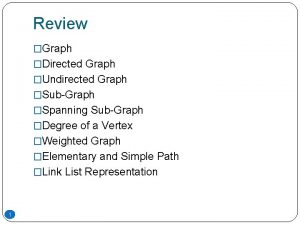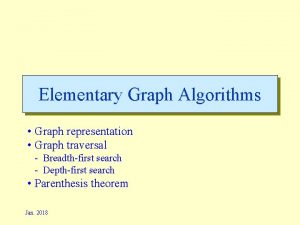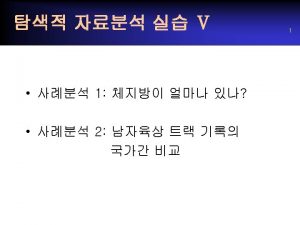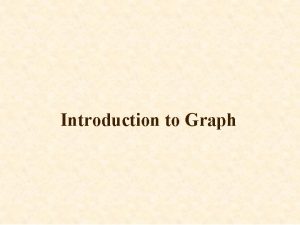Figure 1 1 Graph of an analog quantity
































































- Slides: 64

Figure 1. 1 Graph of an analog quantity (temperature versus time). Digital Fundamentals, Tenth Edition Thomas L. Floyd Copyright © 2009 by Pearson Higher Education, Inc. Upper Saddle River, New Jersey 07458 All rights reserved.

Figure 1. 2 Sampled-value representation (quantization) of the analog quantity in Figure 1– 1. Each value represented by a dot can be digitized by representing it as a digital code that consists of a series of 1 s and 0 s. Digital Fundamentals, Tenth Edition Thomas L. Floyd Copyright © 2009 by Pearson Higher Education, Inc. Upper Saddle River, New Jersey 07458 All rights reserved.

Figure 1. 3 A basic audio public address system. Digital Fundamentals, Tenth Edition Thomas L. Floyd Copyright © 2009 by Pearson Higher Education, Inc. Upper Saddle River, New Jersey 07458 All rights reserved.

Figure 1. 4 Basic block diagram of a CD player. Only one channel is shown. Digital Fundamentals, Tenth Edition Thomas L. Floyd Copyright © 2009 by Pearson Higher Education, Inc. Upper Saddle River, New Jersey 07458 All rights reserved.

Figure 1. 5 Logic level ranges of voltage for a digital circuit. Digital Fundamentals, Tenth Edition Thomas L. Floyd Copyright © 2009 by Pearson Higher Education, Inc. Upper Saddle River, New Jersey 07458 All rights reserved.

Figure 1. 6 Ideal pulses. Digital Fundamentals, Tenth Edition Thomas L. Floyd Copyright © 2009 by Pearson Higher Education, Inc. Upper Saddle River, New Jersey 07458 All rights reserved.

Figure 1. 7 Nonideal pulse characteristics. Digital Fundamentals, Tenth Edition Thomas L. Floyd Copyright © 2009 by Pearson Higher Education, Inc. Upper Saddle River, New Jersey 07458 All rights reserved.

Figure 1. 8 Examples of digital waveforms. Digital Fundamentals, Tenth Edition Thomas L. Floyd Copyright © 2009 by Pearson Higher Education, Inc. Upper Saddle River, New Jersey 07458 All rights reserved.

Figure 1. 9 Digital Fundamentals, Tenth Edition Thomas L. Floyd Copyright © 2009 by Pearson Higher Education, Inc. Upper Saddle River, New Jersey 07458 All rights reserved.

Figure 1. 10 Example of a clock waveform synchronized with a waveform representation of a sequence of bits. Digital Fundamentals, Tenth Edition Thomas L. Floyd Copyright © 2009 by Pearson Higher Education, Inc. Upper Saddle River, New Jersey 07458 All rights reserved.

Figure 1. 11 Example of a timing diagram. Digital Fundamentals, Tenth Edition Thomas L. Floyd Copyright © 2009 by Pearson Higher Education, Inc. Upper Saddle River, New Jersey 07458 All rights reserved.

Figure 1. 12 Illustration of serial and parallel transfer of binary data. Only the data lines are shown. Digital Fundamentals, Tenth Edition Thomas L. Floyd Copyright © 2009 by Pearson Higher Education, Inc. Upper Saddle River, New Jersey 07458 All rights reserved.

Figure 1. 13 Digital Fundamentals, Tenth Edition Thomas L. Floyd Copyright © 2009 by Pearson Higher Education, Inc. Upper Saddle River, New Jersey 07458 All rights reserved.

Figure 1. 14 Digital Fundamentals, Tenth Edition Thomas L. Floyd Copyright © 2009 by Pearson Higher Education, Inc. Upper Saddle River, New Jersey 07458 All rights reserved.

Figure 1. 15 The basic logic operations and symbols. Digital Fundamentals, Tenth Edition Thomas L. Floyd Copyright © 2009 by Pearson Higher Education, Inc. Upper Saddle River, New Jersey 07458 All rights reserved.

Figure 1. 16 The NOT operation. Digital Fundamentals, Tenth Edition Thomas L. Floyd Copyright © 2009 by Pearson Higher Education, Inc. Upper Saddle River, New Jersey 07458 All rights reserved.

Figure 1. 17 The AND operation. Digital Fundamentals, Tenth Edition Thomas L. Floyd Copyright © 2009 by Pearson Higher Education, Inc. Upper Saddle River, New Jersey 07458 All rights reserved.

Figure 1. 18 The OR operation. Digital Fundamentals, Tenth Edition Thomas L. Floyd Copyright © 2009 by Pearson Higher Education, Inc. Upper Saddle River, New Jersey 07458 All rights reserved.

Figure 1. 19 The comparison function. Digital Fundamentals, Tenth Edition Thomas L. Floyd Copyright © 2009 by Pearson Higher Education, Inc. Upper Saddle River, New Jersey 07458 All rights reserved.

Figure 1. 20 The addition function. Digital Fundamentals, Tenth Edition Thomas L. Floyd Copyright © 2009 by Pearson Higher Education, Inc. Upper Saddle River, New Jersey 07458 All rights reserved.

Figure 1. 21 An encoder used to encode a calculator keystroke into a binary code for storage or for calculation. Digital Fundamentals, Tenth Edition Thomas L. Floyd Copyright © 2009 by Pearson Higher Education, Inc. Upper Saddle River, New Jersey 07458 All rights reserved.

Figure 1. 22 A decoder used to convert a special binary code into a 7 -segment decimal readout. Digital Fundamentals, Tenth Edition Thomas L. Floyd Copyright © 2009 by Pearson Higher Education, Inc. Upper Saddle River, New Jersey 07458 All rights reserved.

Figure 1. 23 Illustration of a basic multiplexing/demultiplexing application. Digital Fundamentals, Tenth Edition Thomas L. Floyd Copyright © 2009 by Pearson Higher Education, Inc. Upper Saddle River, New Jersey 07458 All rights reserved.

Figure 1. 24 Example of the operation of a 4 -bit serial shift register. Each block represents one storage “cell” or flip-flop. Digital Fundamentals, Tenth Edition Thomas L. Floyd Copyright © 2009 by Pearson Higher Education, Inc. Upper Saddle River, New Jersey 07458 All rights reserved.

Figure 1. 25 Example of the operation of a 4 -bit parallel shift register. Digital Fundamentals, Tenth Edition Thomas L. Floyd Copyright © 2009 by Pearson Higher Education, Inc. Upper Saddle River, New Jersey 07458 All rights reserved.

Figure 1. 26 Illustration of basic counter operation. Digital Fundamentals, Tenth Edition Thomas L. Floyd Copyright © 2009 by Pearson Higher Education, Inc. Upper Saddle River, New Jersey 07458 All rights reserved.

Figure 1. 27 Block diagram of a tablet-bottling system. Digital Fundamentals, Tenth Edition Thomas L. Floyd Copyright © 2009 by Pearson Higher Education, Inc. Upper Saddle River, New Jersey 07458 All rights reserved.

Figure 1. 28 Cutaway view of one type of fixed-function IC package (dual in-line package) showing the chip mounted inside, with connections to input and output pins. Digital Fundamentals, Tenth Edition Thomas L. Floyd Copyright © 2009 by Pearson Higher Education, Inc. Upper Saddle River, New Jersey 07458 All rights reserved.

Figure 1. 29 Examples of through-hole and surface-mounted devices. The DIP is larger than the SOIC with the same number of leads. This particular DIP is approximately 0. 785 in. long, and the SOIC is approximately 0. 385 in. long. Digital Fundamentals, Tenth Edition Thomas L. Floyd Copyright © 2009 by Pearson Higher Education, Inc. Upper Saddle River, New Jersey 07458 All rights reserved.

Figure 1. 30 Examples of SMT package configurations. Parts (e) and (f) show bottom views. Digital Fundamentals, Tenth Edition Thomas L. Floyd Copyright © 2009 by Pearson Higher Education, Inc. Upper Saddle River, New Jersey 07458 All rights reserved.

Figure 1. 31 Pin numbering for standard types of IC packages. Top views are shown. Digital Fundamentals, Tenth Edition Thomas L. Floyd Copyright © 2009 by Pearson Higher Education, Inc. Upper Saddle River, New Jersey 07458 All rights reserved.

Figure 1. 32 Typical digital oscilloscopes. Used with permission from Tektronix, Inc. Digital Fundamentals, Tenth Edition Thomas L. Floyd Copyright © 2009 by Pearson Higher Education, Inc. Upper Saddle River, New Jersey 07458 All rights reserved.

Figure 1. 33 Basic comparison of analog and digital oscilloscope operation. Digital Fundamentals, Tenth Edition Thomas L. Floyd Copyright © 2009 by Pearson Higher Education, Inc. Upper Saddle River, New Jersey 07458 All rights reserved.

Figure 1. 34 Block diagram of an analog oscilloscope. Digital Fundamentals, Tenth Edition Thomas L. Floyd Copyright © 2009 by Pearson Higher Education, Inc. Upper Saddle River, New Jersey 07458 All rights reserved.

Figure 1. 35 Block diagram of a digital oscilloscope. Digital Fundamentals, Tenth Edition Thomas L. Floyd Copyright © 2009 by Pearson Higher Education, Inc. Upper Saddle River, New Jersey 07458 All rights reserved.

Figure 1. 36 Representation of a typical digital oscilloscope front panel. Numbers below screen indicate the values for each division on the vertical (voltage) and horizontal (time) scales and can be varied using the vertical and horizontal controls on the scope. Digital Fundamentals, Tenth Edition Thomas L. Floyd Copyright © 2009 by Pearson Higher Education, Inc. Upper Saddle River, New Jersey 07458 All rights reserved.

Figure 1. 37 Comparison of an untriggered and a triggered waveform on an oscilloscope. Digital Fundamentals, Tenth Edition Thomas L. Floyd Copyright © 2009 by Pearson Higher Education, Inc. Upper Saddle River, New Jersey 07458 All rights reserved.

Figure 1. 38 Displays of the same waveform having a dc component. Digital Fundamentals, Tenth Edition Thomas L. Floyd Copyright © 2009 by Pearson Higher Education, Inc. Upper Saddle River, New Jersey 07458 All rights reserved.

Figure 1. 39 An oscilloscope voltage probe. Used with permission from Tektronix, Inc. Digital Fundamentals, Tenth Edition Thomas L. Floyd Copyright © 2009 by Pearson Higher Education, Inc. Upper Saddle River, New Jersey 07458 All rights reserved.

Figure 1. 40 Probe compensation conditions. Digital Fundamentals, Tenth Edition Thomas L. Floyd Copyright © 2009 by Pearson Higher Education, Inc. Upper Saddle River, New Jersey 07458 All rights reserved.

Figure 1. 41 Digital Fundamentals, Tenth Edition Thomas L. Floyd Copyright © 2009 by Pearson Higher Education, Inc. Upper Saddle River, New Jersey 07458 All rights reserved.

Figure 1. 42 Typical logic analyzer. Used with permission from Tektronix, Inc. Digital Fundamentals, Tenth Edition Thomas L. Floyd Copyright © 2009 by Pearson Higher Education, Inc. Upper Saddle River, New Jersey 07458 All rights reserved.

Figure 1. 43 Simplified block diagram of a logic analyzer. Digital Fundamentals, Tenth Edition Thomas L. Floyd Copyright © 2009 by Pearson Higher Education, Inc. Upper Saddle River, New Jersey 07458 All rights reserved.

Figure 1. 44 Two logic analyzer display modes. Digital Fundamentals, Tenth Edition Thomas L. Floyd Copyright © 2009 by Pearson Higher Education, Inc. Upper Saddle River, New Jersey 07458 All rights reserved.

Figure 1. 45 A typical multichannel logic analyzer probe. Used with permission from Tektronix, Inc. Digital Fundamentals, Tenth Edition Thomas L. Floyd Copyright © 2009 by Pearson Higher Education, Inc. Upper Saddle River, New Jersey 07458 All rights reserved.

Figure 1. 46 Typical signal generators. Used with permission from Tektronix, Inc. Digital Fundamentals, Tenth Edition Thomas L. Floyd Copyright © 2009 by Pearson Higher Education, Inc. Upper Saddle River, New Jersey 07458 All rights reserved.

Figure 1. 47 Typical DMMs. Courtesy of B+K Precision. ® Digital Fundamentals, Tenth Edition Thomas L. Floyd Copyright © 2009 by Pearson Higher Education, Inc. Upper Saddle River, New Jersey 07458 All rights reserved.

Figure 1. 48 Typical dc power supplies. Courtesy of B+K Precision. ® Digital Fundamentals, Tenth Edition Thomas L. Floyd Copyright © 2009 by Pearson Higher Education, Inc. Upper Saddle River, New Jersey 07458 All rights reserved.

Figure 1. 49 Illustration of how a typical logic pulser and a logic probe can be used to apply a pulse to a given point and check for resulting pulse activity at another part of the circuit. Indications may vary depending on manufacturer. Digital Fundamentals, Tenth Edition Thomas L. Floyd Copyright © 2009 by Pearson Higher Education, Inc. Upper Saddle River, New Jersey 07458 All rights reserved.

Figure 1. 50 Programmable logic. Digital Fundamentals, Tenth Edition Thomas L. Floyd Copyright © 2009 by Pearson Higher Education, Inc. Upper Saddle River, New Jersey 07458 All rights reserved.

Figure 1. 51 Block diagrams of simple programmable logic devices (SPLDs). Digital Fundamentals, Tenth Edition Thomas L. Floyd Copyright © 2009 by Pearson Higher Education, Inc. Upper Saddle River, New Jersey 07458 All rights reserved.

Figure 1. 52 A typical SPLD package. Digital Fundamentals, Tenth Edition Thomas L. Floyd Copyright © 2009 by Pearson Higher Education, Inc. Upper Saddle River, New Jersey 07458 All rights reserved.

Figure 1. 53 General block diagram of a CPLD. Digital Fundamentals, Tenth Edition Thomas L. Floyd Copyright © 2009 by Pearson Higher Education, Inc. Upper Saddle River, New Jersey 07458 All rights reserved.

Figure 1. 54 Typical CPLD packages. Digital Fundamentals, Tenth Edition Thomas L. Floyd Copyright © 2009 by Pearson Higher Education, Inc. Upper Saddle River, New Jersey 07458 All rights reserved.

Figure 1. 55 Basic structure of an FPGA. Digital Fundamentals, Tenth Edition Thomas L. Floyd Copyright © 2009 by Pearson Higher Education, Inc. Upper Saddle River, New Jersey 07458 All rights reserved.

Figure 1. 56 A typical ball-grid array (BGA) package. Digital Fundamentals, Tenth Edition Thomas L. Floyd Copyright © 2009 by Pearson Higher Education, Inc. Upper Saddle River, New Jersey 07458 All rights reserved.

Figure 1. 57 Basic setup for programming a PLD or FPGA. Digital Fundamentals, Tenth Edition Thomas L. Floyd Copyright © 2009 by Pearson Higher Education, Inc. Upper Saddle River, New Jersey 07458 All rights reserved.

Figure 1. 58 Basic programmable logic design flow block diagram. Digital Fundamentals, Tenth Edition Thomas L. Floyd Copyright © 2009 by Pearson Higher Education, Inc. Upper Saddle River, New Jersey 07458 All rights reserved.

Figure 1. 59 Digital Fundamentals, Tenth Edition Thomas L. Floyd Copyright © 2009 by Pearson Higher Education, Inc. Upper Saddle River, New Jersey 07458 All rights reserved.

Figure 1. 60 Digital Fundamentals, Tenth Edition Thomas L. Floyd Copyright © 2009 by Pearson Higher Education, Inc. Upper Saddle River, New Jersey 07458 All rights reserved.

Figure 1. 61 Digital Fundamentals, Tenth Edition Thomas L. Floyd Copyright © 2009 by Pearson Higher Education, Inc. Upper Saddle River, New Jersey 07458 All rights reserved.

Figure 1. 62 Digital Fundamentals, Tenth Edition Thomas L. Floyd Copyright © 2009 by Pearson Higher Education, Inc. Upper Saddle River, New Jersey 07458 All rights reserved.

Figure 1. 63 Digital Fundamentals, Tenth Edition Thomas L. Floyd Copyright © 2009 by Pearson Higher Education, Inc. Upper Saddle River, New Jersey 07458 All rights reserved.

Figure 1. 64 Digital Fundamentals, Tenth Edition Thomas L. Floyd Copyright © 2009 by Pearson Higher Education, Inc. Upper Saddle River, New Jersey 07458 All rights reserved.
 Line grid array
Line grid array Example of scalar quantities
Example of scalar quantities What is vector quantity
What is vector quantity Speed has magnitude only
Speed has magnitude only Vary inversly
Vary inversly Scalar vector tensor
Scalar vector tensor Socially efficient quantity
Socially efficient quantity Profit maximizing
Profit maximizing Loanable funds market
Loanable funds market Equalibrium
Equalibrium An operation that maps an original figure onto a new figure
An operation that maps an original figure onto a new figure 6 figure grid reference
6 figure grid reference Abcye
Abcye Washing machine solid or plane figure
Washing machine solid or plane figure Reflections on a coordinate plane worksheet
Reflections on a coordinate plane worksheet Handshaking theorem
Handshaking theorem Resource allocation graph and wait for graph
Resource allocation graph and wait for graph How analog video works
How analog video works How analog video works
How analog video works Compare and contrast analog and digital forecasts
Compare and contrast analog and digital forecasts Analog appearance
Analog appearance Apa yang dimaksud teknologi digital
Apa yang dimaksud teknologi digital Rangkaian modulator am
Rangkaian modulator am Analog vs digital
Analog vs digital Analog devices part numbering system
Analog devices part numbering system Combinatii pictograme tahograf
Combinatii pictograme tahograf Analog v digital
Analog v digital Modulation digital to analog
Modulation digital to analog Analog meter movement
Analog meter movement Digital to analog modulation techniques
Digital to analog modulation techniques Kelebihan elektronika analog adalah….
Kelebihan elektronika analog adalah…. Analog lagtolkning
Analog lagtolkning Analog information
Analog information Analog mixed signal verification
Analog mixed signal verification Introduction to digital video
Introduction to digital video Filter analog
Filter analog Lamba parlaklığı formülü
Lamba parlaklığı formülü Difference between analog and digital editing
Difference between analog and digital editing Amw huebsch
Amw huebsch Fidelity in receiver
Fidelity in receiver Data and signals
Data and signals Oscillator analog electronics
Oscillator analog electronics White noise in analog communication
White noise in analog communication Cadence analog design environment
Cadence analog design environment Types of analog filters
Types of analog filters Basics of analog video
Basics of analog video Bandwidth analog adalah
Bandwidth analog adalah Vhmin
Vhmin Adc converter types
Adc converter types Characteristics of analog signals
Characteristics of analog signals Adc types
Adc types Emt 112
Emt 112 Analog communication system
Analog communication system Apa kepanjangan dari adc
Apa kepanjangan dari adc Analog circuit behavior
Analog circuit behavior Contoh soal sinyal kontinyu
Contoh soal sinyal kontinyu Sinyal periodik
Sinyal periodik Digital vs analog sound
Digital vs analog sound Analog signla
Analog signla Digital signal as a composite analog signal
Digital signal as a composite analog signal Chapter 15 food analogs substitute ingredients
Chapter 15 food analogs substitute ingredients 1149/4
1149/4 Data yang diolah oleh komputer analog
Data yang diolah oleh komputer analog Alkoholy a fenoly
Alkoholy a fenoly Various calculating devices
Various calculating devices
